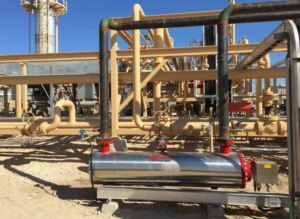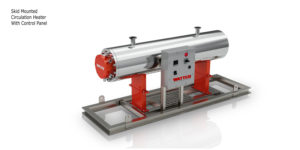Industrial Steam, Gas, Air and Corrosive Heating using Circulation Heaters
Last updated on November 3rd, 2023 at 07:07 pm
Circulation heaters are a type of immersion heater that fall under the in-line category heating variety owing to their design that allows for a wide range of power wattage densities. What makes these types of heaters special is that their design is for heating specific types of fluid. This means that process specifications like viscosity, flow rate and liquid temperature limits will already have been set for the circulation heater. Circulation heaters can mount both horizontally and vertically in the heating container depending on their application.
Circulation Heaters in Steam, Air & Gas Heating 
It is common knowledge that circulation heaters are a very cost-efficient solution to heating air, steam and common industrial gases like Nitrogen, Helium and Argon among others. This heater is also perfect for heating a wide range of gas mixtures and industrial elements like INCOLOY® metals. It’s also good for core industrial processes such as enhancing safe operations in Stainless steel vessel heating and heating corrosive and flammable gases even at temperatures over 800°C.
Circulation heaters also come in handy when better quality steam and enthalpy is required in a heating process. Smaller circulation heaters are also commonly used in line loses in gas and steam generation and distribution processes.
Most Suitable Heater Guideline
- Flanged or Screw Plug Heater Design
- 5 – 50 cm Carbon Steel Pipe Body, and up to 70 kg in mass.
- 1– 350 kW
- Often available in 1 & 3 Phase power input with 120, 240 and 480V rating.
- With or Without Thermostat
- 1.2 cm diameter with protected sheath such as those made from INCOLOY® Sheath Elements (15 – 23 W/In2)
- These heaters are perfect for moisture resistant heating, moisture resistant terminal enclosures heating, explosion and corrosion resistant heating and general purpose heating.
Circulation Heaters in High-Temperature Gas & Corrosive Solutions Heating
 Among the most popular uses of circulation heaters in industrial processes is mildly heating corrosive solutions, with acidity values of between pH5 and pH9 with stainless steel elements and passivized stainless pipe construction. One of the highest performing heaters made out of INCOLOY and stainless steel provide long service life. Even when heating highly corrosive concoctions and elements such as sulfur laden oils.
Among the most popular uses of circulation heaters in industrial processes is mildly heating corrosive solutions, with acidity values of between pH5 and pH9 with stainless steel elements and passivized stainless pipe construction. One of the highest performing heaters made out of INCOLOY and stainless steel provide long service life. Even when heating highly corrosive concoctions and elements such as sulfur laden oils.
The sheathing of a circulation heater is often reinforced with the right metals to protect it from the fluids (liquids and gases) that the heater will be used to heat. This sheathing often goes beyond helping protect the heater from damage, corrosion and overheating. It also improves the safety of heating even when the operation requires superheating gas and air to temperatures beyond 1,000°C. While fuel and oil heaters may seem like viable options in such a case, electric circulation heaters are more efficient, safer, faster and cheaper.
Best Circulation Heater Guideline
- Flanged or Screw Plug Heater Design.
- 6 to 36 cm type 304 Stainless Steel Pipe Body, about 70 kg.
- 2 – 200 kW power rating
- 1 & 3 Phase power mains input, choice of 120, 240 and 480V.
- Suitable for explosion resistant, corrosive gas and liquid, moisture resistant and general purpose heating.
- Can come with or without a thermostat.
